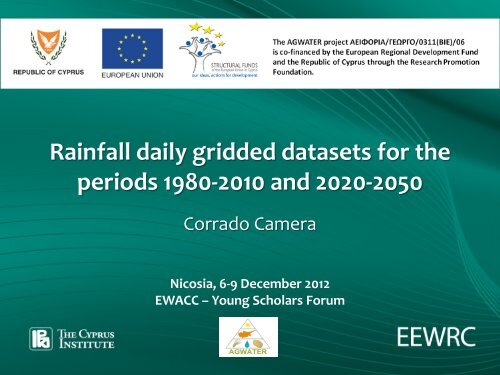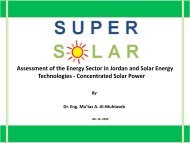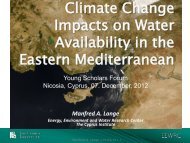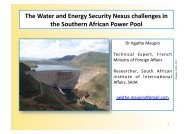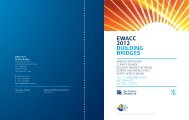Rainfall daily gridded datasets for the periods 1980-2010 and 2020-2050
Corrado Camera - EWACC 2012 - Building Bridges
Corrado Camera - EWACC 2012 - Building Bridges
You also want an ePaper? Increase the reach of your titles
YUMPU automatically turns print PDFs into web optimized ePapers that Google loves.
<strong>Rainfall</strong> <strong>daily</strong> <strong>gridded</strong> <strong>datasets</strong> <strong>for</strong> <strong>the</strong><br />
<strong>periods</strong> <strong>1980</strong>-<strong>2010</strong> <strong>and</strong> <strong>2020</strong>-<strong>2050</strong><br />
Corrado Camera<br />
Nicosia, 6-9 December 2012<br />
EWACC – Young Scholars Forum
Outlines<br />
• Introduction<br />
• Contest <strong>and</strong> aim<br />
• Gridded <strong>datasets</strong> <strong>for</strong> past times<br />
• Available data <strong>and</strong> <strong>the</strong>ir reliability (Observational data)<br />
• Selection of <strong>the</strong> best interpolation technique<br />
• Gridded <strong>datasets</strong> <strong>for</strong> future times<br />
• Available data (RCMs)<br />
• Downscaling<br />
• Interpolation
Introduction<br />
Eastern Mediterranean heavily affected by future climate change<br />
Enhanced water scarcity<br />
Need <strong>for</strong> reliable adaptation measures
Introduction<br />
Very dry < 400 mm/y<br />
Very wet > 600 mm/y
Introduction<br />
DIMINISHING RAINFALL<br />
GRIDDED DAILY DATASETS<br />
RESOLUTION 1X1 KM<br />
Effects on hydrological regime<br />
Effects on groundwater recharge<br />
<strong>and</strong> surface water flow<br />
Effects on GW amount <strong>and</strong> quality<br />
UNDERSTAND<br />
?<br />
QUANTIFY<br />
MODELS<br />
Effects on man’s activities<br />
ADAPT
Datasets <strong>for</strong> past times<br />
INPUT OBSERVATIONAL DATA<br />
Period <strong>1980</strong> - <strong>2010</strong><br />
Now 74 stations (only Greek Cyprus)<br />
Target 130 stations (whole isl<strong>and</strong>)<br />
Daily data<br />
Gaps filled<br />
Data tested <strong>for</strong> homogeneity
Introduction to Interpolation Techniques<br />
• Few works with <strong>daily</strong> data, mainly monthly<br />
• General scheme simple (single) methods – complex (combined) methods<br />
SIMPLE METHODS<br />
Regression geographical variables<br />
• Linear multiple regression (LMR)<br />
• Geographically weighted regression<br />
(GWR)<br />
• Step Wise Regression (SW)<br />
Neighbouring interpolation<br />
• Inverse distance weighting (IDW)<br />
• Angular Distance weighting (ADW)<br />
• Kriging (KR)<br />
• Thin Plate Splines (TPS)<br />
COMBINED METHODS<br />
Regression + residuals interpolation<br />
Geographical variables:<br />
• Regression (LMR, GWR, SWLMR,<br />
SWGWR)<br />
Residuals after regression:<br />
• interpolation (IDW, ADW, KR, TPS)<br />
Sum two contributions
Variables <strong>for</strong> regression<br />
Variables representative of <strong>the</strong> processes<br />
Differences winter-summer<br />
AUTUMN-WINTER:<br />
L<strong>and</strong>-sea effects<br />
Orographic effects<br />
Mountain shadow effects<br />
SPRING-SUMMER:<br />
Convective processes<br />
Orographic effects<br />
Mountain shadow effects
Variables <strong>for</strong> regression<br />
SEASONAL MEANS FOR THE PERIOD <strong>1980</strong>-<strong>2010</strong> (IDW)
Variables <strong>for</strong> regression<br />
Six variables: 1) altitude, 2) distance from coast, 3) distance from <strong>the</strong><br />
mountains main ridge to <strong>the</strong> east <strong>and</strong> 4) to <strong>the</strong> west, 5) easting; 6) northing
Regressions<br />
REGRESSION METHODS<br />
• Multiple linear regression (lmr)<br />
• Geographically weighted regression (gwr)<br />
• Step wise regression based on AIC (swr) AIC accuracy-complexity measure<br />
INTERPOLATION METHODS<br />
• Inverse Distance Weighting (IDW)<br />
• Angular Distance Weighting (ADW)<br />
• 3D Thin Plate Splines (3DTPS)<br />
• Kriging<br />
EVALUATION METHODS<br />
• CRE compound relative error<br />
• NRMSE normalized RMSE<br />
• MAE mean absolute error<br />
• R Pearson coefficient<br />
• RMSE root mean squared error<br />
• CSI critical success index<br />
• Test subset 36 days (rain 0, min, max, 3 rd , 6 th … 99 th percentile area average)<br />
• Evaluation - Ranking station by station, day by day
Ranking methods<br />
days<br />
stations<br />
Models Ave rank CRE # MAE # RMSE # NRMSE # R # CSI # CSI.extr # CRE # MAE # RMSE # NRMSE # R # CSI # CSI.extr #<br />
swlmridw<br />
1.93 0.70 1 1.80 2 2.75 1 0.14 1 0.49 1 0.50 3 0.29 2 0.74 2 1.80 2 4.73 2 0.07 3 0.96 2 0.82 3 0.86 2<br />
idw 2.64 0.71 2 1.85 5 2.79 3 0.14 2 0.49 2 0.47 4 0.23 4 0.62 1 1.85 5 4.71 1 0.07 5 0.97 1 0.83 1 0.91 1<br />
gwr-idw 2.86 0.75 4 1.77 1 2.83 4 0.14 4 0.49 3 0.51 1 0.31 1 0.86 7 1.77 1 4.74 3 0.07 1 0.96 4 0.82 2 0.85 4<br />
lmr-idw 3.36 0.72 3 1.83 4 2.79 2 0.14 3 0.48 4 0.51 2 0.29 3 0.75 3 1.83 3 4.79 5 0.07 4 0.96 3 0.81 5 0.86 3<br />
gwr 4.50 0.78 5 1.81 3 2.88 5 0.14 5 0.43 5 0.45 5 0.22 5 0.83 5 1.81 4 4.77 4 0.07 2 0.95 5 0.81 4 0.85 6<br />
swlmr 6.07 0.78 6 2.02 6 3.01 6 0.15 6 0.36 7 0.42 6 0.17 7 0.83 4 2.02 6 5.28 6 0.08 6 0.94 6 0.79 6 0.84 7<br />
lmr 6.64 0.81 7 2.07 7 3.08 7 0.15 7 0.36 6 0.41 7 0.18 6 0.86 6 2.07 7 5.37 7 0.08 7 0.93 7 0.78 7 0.85 5
Gridded <strong>datasets</strong> <strong>for</strong> future times<br />
DATA RETRIEVAL PERIOD <strong>2020</strong>-<strong>2050</strong><br />
Suitable source Climate Models (past calibration – future prediction)<br />
• GCMs Global - CO 2 emission scenarios - resolution 300 km<br />
• RCMs smaller areas (e.g. Europe) - dynamical downscaling GCM - resolution 25 km<br />
IPCC, 2007
Gridded <strong>datasets</strong> <strong>for</strong> future times<br />
6 RCMs from ENSEMBLES 2 models <strong>for</strong> 3 different <strong>for</strong>cing GCMs<br />
Institution Driving GCM Model Acronym<br />
CNRM ARPEGE_RM5.1 Aladin CNRM-RM5.1<br />
ETHZ HadCM3Q0 CLM ETHZ-CLM<br />
KNMI ECHAM5-r3 RACMO KNMI-RACMO2<br />
METNO BCM HIRHAM METNOHIRHAM<br />
METO-HC HadCM3Q0 HadRM3Q0 METO-HC_HadRM3Q0<br />
MPI ECHAM5-r3 REMO MPI-M-REMO<br />
Select one<br />
scores to evaluate models per<strong>for</strong>mance VS observed values:<br />
• point values<br />
• spatial trend<br />
Mean yearly<br />
value
Gridded <strong>datasets</strong> <strong>for</strong> future times<br />
MEAN ANNUAL RAINFALL (<strong>1980</strong>-<strong>2010</strong>) - OBSERVATIONS
Gridded <strong>datasets</strong> <strong>for</strong> future times<br />
MEAN ANNUAL RAINFALL (<strong>1980</strong>-<strong>2010</strong>) - MODELS
Gridded <strong>datasets</strong> <strong>for</strong> future times<br />
FROM RCM TO OBSERVATIONAL POINTS<br />
ASSUMING<br />
Stationary climate <strong>for</strong> a 30 years period<br />
DOWNSCALING<br />
• Monthly base • Skewness<br />
• Mean<br />
• Pdry<br />
• Variance • Auto-correlation<br />
Change factors (α)<br />
USING<br />
P<br />
P<br />
P<br />
Fut<br />
Obs<br />
Fut<br />
RCMFut<br />
RCMFut<br />
P<br />
= where P<br />
= α<br />
RCMCon<br />
RCMCon<br />
P<br />
P<br />
Obs<br />
= α ⋅ P<br />
P = any variable
Gridded <strong>datasets</strong> <strong>for</strong> future times<br />
HOW TO PASS FROM STATISTICS TO COMPLETE DAILY RAINFALL TIMESERIES?<br />
Stochastic rainfall model - Neyman-Scott Rectangular Pulses (NSRP) model<br />
RAINFALL GENERATOR<br />
MODEL PARAMETERS<br />
Storm origin time (λ) [h -1 ]<br />
Number of raincells (ν) [-]<br />
Raincell origin delay (β) [h -1 ]<br />
Raincell intensity (ξ) [h/mm]<br />
Raincell duration (η) [h -1 ]<br />
Fitted from rainfall monthly statistics<br />
Arriving as a Poisson process<br />
Simulation as long as desired
Conclusions<br />
• General setting<br />
• Testing <strong>and</strong> implementing more interpolation methods<br />
• Implementing quantitative RCM skill score<br />
• <strong>Rainfall</strong> generator outputs<br />
• Extension of <strong>the</strong> work to o<strong>the</strong>r variables (e.g. temperature)<br />
ANY QUESTION OR SUGGESTION IS WELCOME<br />
• Adriana Bruggeman<br />
• Panos Hadjinicolau<br />
• Evangelos Tyrlis<br />
• Andries De Vries<br />
ACKNOWLEDGEMENTS<br />
• Nick Polydorides<br />
• Hakan Djuma<br />
• Stelios Pashiardis
References<br />
Burton A, Fowler HJ, Blenkinsop S, Kilsby CG (<strong>2010</strong>) Downscaling transient climate change using a Neyman-Scott Rectangular Pulses<br />
stochastic rainfall model. J Hydrol 381, 18-32.<br />
Kilsby CG, Jones PD, Burton A, Ford AC, Fowler HJ, Harpham C, James P, Smith A, Wilby RL (2007) A <strong>daily</strong> wea<strong>the</strong>r generator <strong>for</strong> use<br />
in climate change studies. Environ Modelling Software 22, 1705-1719.<br />
Frei C, Schär C (1998), A precipitation climatology of <strong>the</strong> alps from high-resolution rain-gauge observations, Int. J. Climatol., 18, 873–<br />
900.<br />
Haylock MR, et al (2008), A European high resolution <strong>gridded</strong> data set of surface temperature <strong>and</strong> precipitation <strong>for</strong> 1950-2006, J.<br />
Geophys. Res. 113, D20119, doi:10.1029/2008JD010201.<br />
Hofstra N, et al (2008), Comparison of six methods <strong>for</strong> <strong>the</strong> interpolation of <strong>daily</strong> European climate data, J. Geophys. Res. 113, D21110,<br />
doi:10.1029/2008JD010100.<br />
Hutchinson MF (1995) Stochastic space-time wea<strong>the</strong>r models from ground-based data. Agricultural <strong>and</strong> Forest Meteorology 73, 237-<br />
264.<br />
Maraun D, Wetterhall F, Ireson AM, Ch<strong>and</strong>ler RE, Kendon EJ, Widmann M, Brienen S, Rust HW, Sauter T, Themeßl, Venema VKC,<br />
Chun KP, Goodess CM, Jones RG, Onof C, Vrac M, Thiele-Eich I (<strong>2010</strong>) Precipitation downscaling under climate change: recent<br />
developments to bridge <strong>the</strong> gap between dynamical models <strong>and</strong> <strong>the</strong> end user. Reviews of Geophysics 48, RG3003, 34 pp<br />
Perry M, Hollis D (2005), The generation of monthly <strong>gridded</strong> <strong>datasets</strong> <strong>for</strong> a range of climate variables over <strong>the</strong> UK, Int. J. Climatol.,<br />
25, 1041–1054, doi:10.1002/joc.1161.


